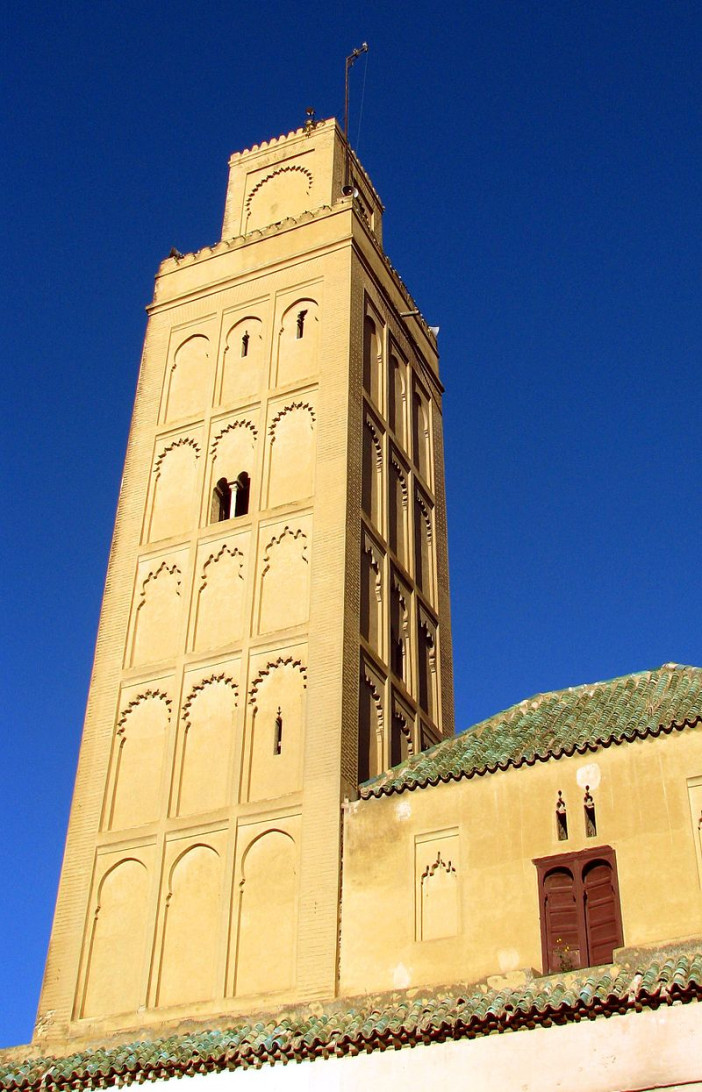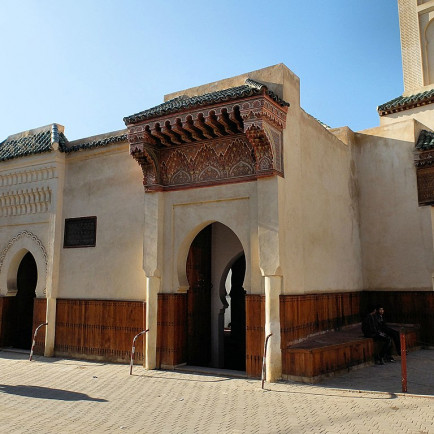Bab Berdieyinne Mosque
History
The mosque is called after the neighboring Bab al-Bard'iyin city gate, which likely got its name from a nearby old market where people sold packsaddles (al-Bard'iyin). [2] A Berber chief named Ali ibn Yashu al-Yazghi oversaw the mosque's construction, which was finished in 1709 CE, during the rule of the Alaouite ruler Moulay Isma'il, according to inscriptions found inside the mosque. [2] Meknes was proclaimed the capital of Morocco by Moulay Isma'il, who also erected a sizable fortress and palace complex next to it. As a result, the city's mosques and other buildings were frequently built or renovated throughout his reign.
Khnata bent Bakkar, the sultan's wife who served as his vizier (minister) before his death in 1728, is credited with taking the initiative to build the mosque.
During the Sultanate of Moulay Muhammad ibn Abdallah (1757–1790) and the French Protectorate under Moulay Yusuf, the mosque was repaired and refurbished (1912-1927).
Urban and Architectural
The mosque has a 620 square meter surface area. It consists of an inner courtyard and a prayer hall with three transverse aisles that run parallel to the qibla wall (sahn). The highest minaret in the city is made of brick and dates back to Moulay Isma'il's rule. It has a square base, and each of its four facades is decorated with straightforward, nearly identical blind arches.
Collapse of the minaret in 2010
The Bab Berdieyinne mosque's minaret collapsed on February 19, 2010.
[9] The minaret, which was made of rammed earth, has been blamed for becoming weaker after several days of heavy rain. Of the 300 worshipers present, 41 died, 75 were hurt, and some were buried beneath the debris. Rescue efforts were hampered by the mosque's constrained entryways and the possibility of additional walls collapsing.
The collapse happened at 12.45 GMT on February 19, 2010, and the administration has attributed it to several days of intense rain in the region.
Through floods, the rains has claimed lives, and they also ruined crops and highways. Friday prayers were taking place at the mosque with more than 300 worshipers present, and the imam was ready to begin his speech when it collapsed. The discourse was scheduled to include funeral prayers, and there was a body in the mosque. On February 20, the final body was found inside the mosque, bringing the total number of fatalities and injuries to 41.
Rescuers used shovels and their bare hands to clear the rubble after it was reported that up to 80 people were once buried beneath it. The less critically injured are being treated in a hospital in Meknes, while the seriously injured have been transported to Fes. Of the 75 injured, 17 needed long-term inpatient care.
Description
The country's interior and religious affairs ministries visited the scene and the injured people in the hospital as part of a search and rescue operation. A group of psychologists was dispatched to the location. Due to the difficulty in using heavy equipment in the tiny alleys and the precarious condition of the surrounding homes and businesses' walls, the rescue effort was hindered.
References
he Rough Guide to Morocco (11th ed.). Rough Guides. 2016.
El Khammar, Abdeltif (2005). "Mosquées et oratoires de Meknès (IXe-XVIIIe siècle) : géographie religieuse, architecture et problème de la Qibla". PhD Thesis. Université Lumière-Lyon 2. p. 210.
"Dozens die in Morocco minaret collapse". BBC News. 19 February 2010. Retrieved 20 February 2010.
Details
Location
Meknes, Morocco
Owners
Khnata bent Bakkar
Year of Build
1709 CE
Area
620 square metres
Drawings
Map
History
The mosque is called after the neighboring Bab al-Bard'iyin city gate, which likely got its name from a nearby old market where people sold packsaddles (al-Bard'iyin). [2] A Berber chief named Ali ibn Yashu al-Yazghi oversaw the mosque's construction, which was finished in 1709 CE, during the rule of the Alaouite ruler Moulay Isma'il, according to inscriptions found inside the mosque. [2] Meknes was proclaimed the capital of Morocco by Moulay Isma'il, who also erected a sizable fortress and palace complex next to it. As a result, the city's mosques and other buildings were frequently built or renovated throughout his reign.
Khnata bent Bakkar, the sultan's wife who served as his vizier (minister) before his death in 1728, is credited with taking the initiative to build the mosque.
During the Sultanate of Moulay Muhammad ibn Abdallah (1757–1790) and the French Protectorate under Moulay Yusuf, the mosque was repaired and refurbished (1912-1927).
Urban and Architectural
The mosque has a 620 square meter surface area. It consists of an inner courtyard and a prayer hall with three transverse aisles that run parallel to the qibla wall (sahn). The highest minaret in the city is made of brick and dates back to Moulay Isma'il's rule. It has a square base, and each of its four facades is decorated with straightforward, nearly identical blind arches.
Collapse of the minaret in 2010
The Bab Berdieyinne mosque's minaret collapsed on February 19, 2010.
[9] The minaret, which was made of rammed earth, has been blamed for becoming weaker after several days of heavy rain. Of the 300 worshipers present, 41 died, 75 were hurt, and some were buried beneath the debris. Rescue efforts were hampered by the mosque's constrained entryways and the possibility of additional walls collapsing.
The collapse happened at 12.45 GMT on February 19, 2010, and the administration has attributed it to several days of intense rain in the region.
Through floods, the rains has claimed lives, and they also ruined crops and highways. Friday prayers were taking place at the mosque with more than 300 worshipers present, and the imam was ready to begin his speech when it collapsed. The discourse was scheduled to include funeral prayers, and there was a body in the mosque. On February 20, the final body was found inside the mosque, bringing the total number of fatalities and injuries to 41.
Rescuers used shovels and their bare hands to clear the rubble after it was reported that up to 80 people were once buried beneath it. The less critically injured are being treated in a hospital in Meknes, while the seriously injured have been transported to Fes. Of the 75 injured, 17 needed long-term inpatient care.
Description
The country's interior and religious affairs ministries visited the scene and the injured people in the hospital as part of a search and rescue operation. A group of psychologists was dispatched to the location. Due to the difficulty in using heavy equipment in the tiny alleys and the precarious condition of the surrounding homes and businesses' walls, the rescue effort was hindered.





